For the future of Okinawa Rail: Toward Developing “One Plan Approach to Conservation”
Okinawa Wildlife Foundation, Nonprofit Organization
Yumiko Nakaya
Crisis of the Okinawa rail
The Okinawa rail is Japan’s only flightless bird that was discovered as a new species in the forested area called “Yanbaru” in the northern part of Okinawa Island in 1981. It has an appearance befitting of its tropical origin, with bright red eyes and feet, black body as a base and white eyelines that go straight from the eyes to the neck, olive-colored wings from the head to the tail, and white horizontal stripes from the chest to the abdomen (Fig. 1).
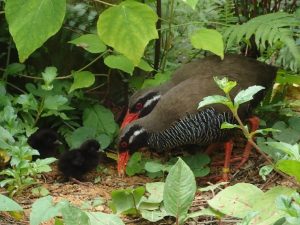
Fig. 1. Parent and child Okinawa rail
The number of birds at the time was estimated to be around 2,000, but in 2005, less than 25 years after its discovery, the number dramatically decreased to around 700, resulting in the designation of the species as “Critically Endangered” in the Red List of the Ministry of the Environment of Japan. The causes of such decline were due to predation by introduced species such as mongooses, dogs, and cats; traffic accidents; and decreased habitats due to environmental changes such as deforestation. The impact of introduced species was a particularly urgent one among these causes.
Okinawa, back in 1910 had a serious threat of potentially lethal pit viper bite attacks. In addition, crop damage caused by black rats was a massive and urgent issue. Therefore, the mongoose was introduced with the aim of exterminating pit vipers and black rats. Only 17 mongooses that were caught at the mouth of the Ganges River in India and released in Naha City in southern Okinawa Island expanded northward while continuing to breed, and by the 1990s had reached the Yanbaru forest, driving the habitat of the Okinawa rail further and further northwards. The current mongoose population inhabiting Okinawa Island is said to be 30,000 individuals. Moreover, stray cats and dogs that were abandoned by humans targeted Okinawa rails in the forest after being driven away from their habitats.
It is thought that the Okinawa rail became a flightless bird because Okinawa Island originally was not inhabited by carnivorous mammals such as weasels and foxes like in Honshu. The Okinawa rails could not compete with introduced varieties of carnivorous mammals such as mongooses and cats that should otherwise not be in the Yanbaru forest and were easily preyed upon as a result.
Conservation activities for avoiding extinction
In the same year as the discovery of the Okinawa rail, the last five wild Japanese crested ibises were captured, and captive breeding efforts were made, but the last Japanese crested ibis born in Japan, “Kin”, died in 2003. The incident showcased the difficulty of restoring species whose numbers were reduced to the brink of extinction. “We cannot have a repetition of what happened with the Japanese crested ibis”. Nobody knew whether the Okinawa rail was trapped in the vortex of extinction, or was still at its edge. Therefore, we have been desperately pursuing conservation activities in an attempt to do everything possible to avoid the extinction of the Okinawa rail.
We created a project team centered on the Okinawa Wildlife Foundation, and in 2006, we invited three coordinators from the IUCN Conservation Breeding Specialist Group (CBSG) [now renamed to Conservation Planning Specialist Group (CPSG)] and hosted the Okinawa Rail Population Viability Analysis Workshop (Okinawa Rail PHVA) at the public hall in Ada Ward, Kunigami Village1). This workshop involved the gathering of 80 experts and associates such as domestic and international researchers, local residents, zoo officials, government agencies, and environmental NGOs, and involved two whole days of discussion and the setting of goals over what kinds of in-situ and ex-situ conservation measures should be taken in order to avoid extinction2). The decisions made in this workshop were not binding, but various projects were developed as a guideline for the maintenance of the Okinawa rail populations.
The first goal was to eliminate mongoose populations from the entire Yanbaru area as part of in-situ conservation, and capture-based control measures were advanced by the Ministry of the Environment of Japan and Okinawa Prefecture. As a result, though there are currently a few surviving individuals around the SF Line (Ogimi Village, Shioya–Higashi Village, Fukuchi), which is the first fence for preventing the northward expansion of mongooses, the aim is the complete elimination of mongooses north of the SF Line by 2026.
The second goal was to undertake measures for cats in the Yanbaru area, and we have started the fixing and microchip treatment of domestic cats in public halls while conducting public awareness campaigns along with the government and residents in order to prevent abandoned cats and dogs. Additionally, as part of the Shimaneko Project, around 1,400 stray cats were housed and transferred out from 2004 to 2018. Cats have progressively been caught, and the Okinawa rail’s habitat distribution has been recovering southward, with rare rats such as the Ryukyu rat and Okinawa spiny rat being observed in the forest. However, autopsies of the corpses of the rare species that are delivered to us revealed that not only Okinawa rails and mice but also even Holst’s frogs are being caught and killed. Many cats, including those kept outside by their owners, are continuing to hunt down the rare species in the Yanbaru forest on a daily basis.
Taking on the challenge of artificial hatching
Meanwhile, since around 2004, we have cultivated treatment and breeding techniques through rescue as part of ex-situ conservation efforts, such as treatments for traffic accidents, artificial hatching of eggs that were abandoned after being attacked by crows, and artificial brooding of chicks that were separated from their parents as a result of falling into ditches (Fig. 2).
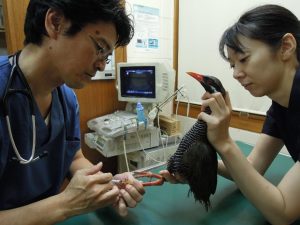
Fig. 2. Blood sampling from the legs for blood tests of rescued individuals
We actively took on the challenge of artificial hatching of the Okinawa rail as well, but whereas with other rail species such as the closely-related white-breasted waterhen, common moorhen, and ruddy crake, whose artificial hatching is relatively easy, the artificial hatching of the Okinawa rail was extremely difficult.
Normally, the Okinawa rail eggs hatch 21 days after the start of incubation, but with our attempt at artificial hatching, the hatchlings began to peck out of their shells on the 20th day, and although the faint sound of the chick could be heard from the egg, it was unable to hatch and many would die in the shell, therefore eggshell incisions were made to extract the chicks just before hatching for many years.
Many fine adjustments were made such as for the incubation temperature and humidity, setting the number of egg turns, and the number of times the eggs were left to cool, but ultimately, we could not overcome the obstacles in our way.
Subsequently, when we were autopsying an Okinawa rail roadkill that was recovered during the breeding season, we noticed that there was no brood patch despite it being the breeding season. The conclusion we arrived at after multiple discussions with the NPO breeding team, bird ecologists, and breeding engineers at zoos in Tokyo was to “cool the eggs”. The breeding team took on the challenge of increasing the cooling time and frequency. As a result, the chicks were successfully able to hatch on their own (Fig. 3). It took seven years to establish this artificial hatching technique.
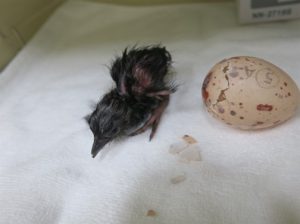
Fig. 3. Okinawa rail chick that hatched on its own
Efforts for natural breeding in captivity and reintroduction to the wild
Following the recommendations of the Okinawa Rail PHVA, we began the captive breeding of the Okinawa rail along with the Ministry of the Environment in 2006, and at present, we manage a captive population of 80 Okinawa rails. Despite this compact captive population, we are developing techniques for breeding that maintains a similar level of genetic diversity as that of wild populations and reintroducing captive individuals into the wild. In 2019, we successfully obtained offspring using artificial insemination for the first time. We also confirmed that sperm that underwent cryopreservation and thawing still had fertilizing ability, and that it may be possible to achieve artificial insemination using frozen sperm (Fig. 4).
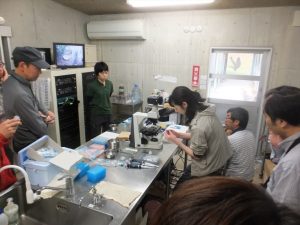
Fig. 4. Semen vitality test and cryopreservation
These successes were only made possible through the collaboration with people in various fields such as veterinary medicine, animal husbandry, ecology, and zoo-based techniques. Currently, we have succeeded in natural breeding in captivity every year, and we have finally begun trial reintroductions to the wild (Fig. 5).
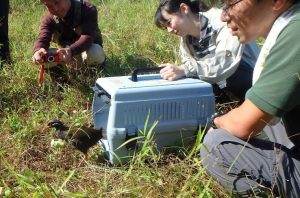
Fig. 5. Wild reintroduction test (2015)
We have conducted training with the Okinawa rails to respond to its natural enemies such as the pit viper or crow as well as be able to adapt to outdoor environments, which has dramatically increased their survival rates after bird release. Furthermore, in 2019, two birds that we released each formed a pair with wild individuals and successfully bred. In the future, we would like to engage in further development of techniques while verifying that many of the released birds will follow in the footsteps of these two birds.
Protecting the future of Yanbaru forest and Okinawa rail
As a result of simultaneously engaging in in-situ and ex-situ conservation of the Okinawa rail, we were able to narrowly escape the crisis situation faced by the species in 2005, with its population recovering to around 1,500 birds. It appears that we were able to avert the extinction of the species.
Recently, the IUCN CPSG has set the One Plan Approach to Conservation Planning (OPA) as an activity philosophy for the conservation of rare species. Rather than the conventional idea that in-situ conservation is at the center and ex-situ conservation has an auxiliary presence, this idea is to achieve the continuation of a species using the two wheels of in-situ and ex-situ conservation, with the conservation of the Okinawa rail being introduced as a successful example of this3). We are aiming to register Yanbaru forest as a World Natural Heritage Site in the summer of 2020. Whether the Okinawa rail will continue to inhabit Yanbaru forest and be passed on as a story with a happy ending in the future depends on us and our actions in the present day.
References
Okinawa Rail PHVA (2006)
URL: http://www.cbsg.org/content/okinawa-rail-phva-2006
Okinawa rail PVA Executive Committee Okinawa rail Probability Viability Analysis Workshop Report 2006
URL:http://www.cbsg.org/sites/cbsg.org/files/documents/Okinawa%20rail%20PHVA%20%282006%29.pdf
Integrated Data Management for Reintroductions and Conservation Translocations URL:http://www.cbsg.org/integrated-data-management-reintroductions-and-translocations

